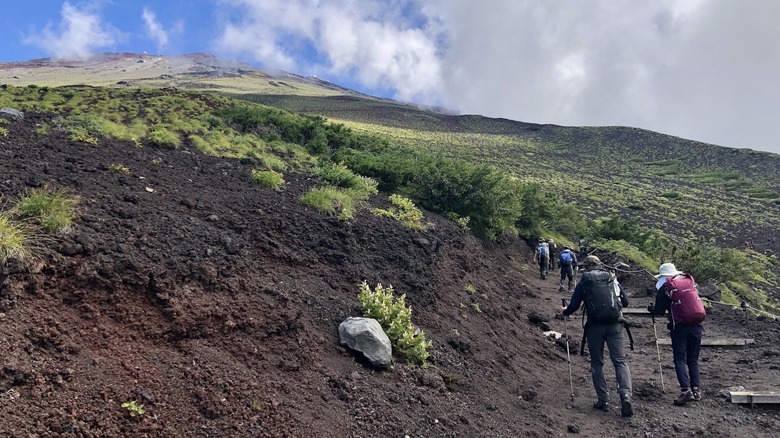Climbing Mount Fuji via the Fujinomiya and Yoshida trails
Mount Fuji has four hiking trails leading up from the two neighboring prefectures it straddles in Chubu, Japan’s central region. Three of the trails are in Shizuoka Prefecture and the other one is in Yamanashi Prefecture. The shortest route to the top of the mountain, and the only one where you’ll ascend and descend the same path, is the Fujinomiya trail in Shizuoka. It starts at the highest altitude, about 2,400 meters, or 7,875 feet, above sea level. From Shinkansen (bullet train) stations like Shizuoka and Shin-Fuji, to local stations like Fuji and Fujinomiya, you can take a direct bus to Mount Fuji’s 5th station and access this trail, pictured above.
Each trail has its own 5th station where cars and buses stop, and the climbing starts. The Yoshida trail is usually the most crowded because it offers sunrise views and is on the Yamanashi side of the mountain, closer to Tokyo and the popular Fuji Five Lakes area. It also has the most mountain huts, where you can sleep and have a hot meal on the way up overnight to see the sunrise. (Reservations are recommended.)
In 2023, a regulation was instated on the Yoshida trail throughout part of the climbing season, requiring hikers to pause when the trail is too congested and wait for others to advance. However, it all might be worth it when you get to the top with everyone else and behold the sunrise.
Other trails and sights in Fuji-Hakone-Izu National Park

Back on the Shizuoka side of Mount Fuji, another climbing option is the Subashiri trail. Like the Yoshida trail, it offers sunrise views. However, it’s less crowded and some locals and English-speaking guides (like Fuji Mountain Guides) prefer it. For experienced hikers, the Gotemba trail is the longest and most challenging, though it comes with the eventual reward of sliding down the “Great Sand Run.” You’ll sometimes encounter thick fog here, but that can happen on any trail as clouds shroud the mountain in mist and mystery.
Remember that reaching the mountaintop is only the halfway point of what could be more than a half-day journey, counting rest hours in huts. At higher elevations, as the oxygen levels drop, Mount Fuji can literally take your breath away. Follow basic hiking safety tips and wear appropriate clothes and footwear. The mountain gets cold — even in summer — and the volcanic rock can be treacherous.
Though Mount Fuji takes the lead in the name, it’s just the beginning of what there is to see in Fuji-Hakone-Izu National Park. Growing out of hardened lava, the nearby Sea of Trees, Aokigahara, has a beauty that belies its notoriety as the “suicide forest.” From the lava caves of the Fuji Five Lakes area to Hakone’s steaming “hell valley,” Owakudani, to the hot springs of the Izu Peninsula and Izu Islands, Fuji-Hakone-Izu National Park will keep you busy with volcano sights long after the climbing is done.

